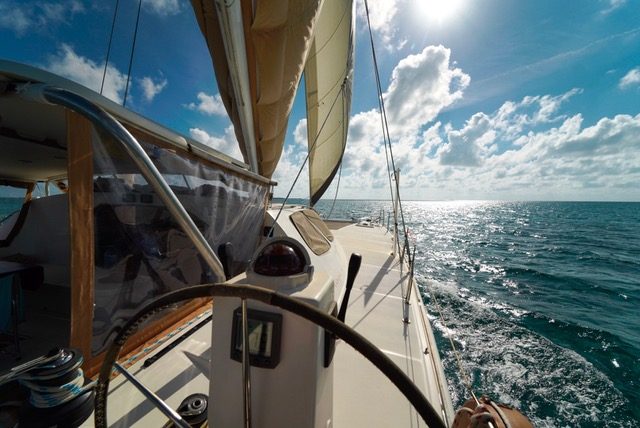Sailing tips: How to increase your catamaran performances?

Have you ever wondered why a sister ship boat is sailing better than your cat? You may be a competitive or a more lay-back sailor but don’t you feel satisfied when you sail faster than a friend? Remember you only need two boats to start a race.
From our sailing experience, here is a list of factors that can affect your catamaran performance. We will not discuss the overall design of your catamaran (daggerboards or keel, windage, etc.) which you cannot easily modify but smaller key points that can make your catamaran sail a few knots faster, or not.
1. Reduce your underwater drag:
- Folding or feathering propellers
Under sails fixed propellers work against the flow of the water, they act as a brake and slow you down by increasing drag. Instead, opt for folding or feathering propellers, you will gain a minimum of half a knot speed.
- Clean hulls
Clean your hulls and make sure to get rid of fouling, barnacles, etc. which creates turbulences. You want to slide through the water with a smooth and clean antifoul.
- Type of antifoul
Like said above, you want to slide through the water with a smooth bottom, and antifoul can have different finish. Hard antifoul can be burnished and wet sanded for a smoother finish while eroding antifoul are rougher (low maintenance). The antifoul you apply on your catamaran will depend on your boat speed and your sailing program but it could also come with a cost on your boat performances.
- Reduce weight
Like monohulls, catamarans are sensitive to weight, therefore try to minimize it. Do you need to have full water and fuel tanks all the time? And if you can, try to centre the weight, it will improve the boat’s behaviour and reduce the pitching.
2. Sails and Rigging:
- Sail Trimming
The sails are the engine of your catamaran and how you trim them is critical to perform better. Use the tell-tales as a guide, they indicate the airflow on your sails. Upwind with a good airflow, you will see the tell-tales flying horizontally, and if not, play with your sheets to add or reduce the tension on the sails and their angle to the wind.
- Sailcut/sailcloth
The type of fabric and the cut influence the capabilities of the sails to drive you forward and, therefore, your boat performances. Take the advice of a sailmaker to see if any adjustment can be made on your sails, or ultimately, if you need to change them. High-end fabrics deform less and are able to hold the sail’s profile longer.
- Rigging tune
Checking the rig tune (mast rake, pre-bend, shrouds tension, etc.) should be part of your maintenance program. An inadequate tune will create weather helm or lee helm and modify the shape of your sail. Unless you know what you are doing, we recommend asking professional riggers to check your rigging.
- Deck Hardware
Nothing is worse than a self-tacking-jib blocking midway when tacking… Check and clean blocks, car’s bearing, tracks then apply lubricant. Also, check your deck hardware for wear and tear, a few bucks spent early, can avoid you large expenses later on.
3. Weather:
- Wind conditions
An overpowered boat is not performing better! We have seen 40 feet cruising cats sailing in 40 knots of wind with full sails out… We will pass you the safety speech and how much pressure you are putting on the rigging and on the structure of your cat… Check the wind conditions ahead and reef early. Reducing the amount of sails will help the overall boat behaviour. It will reduce the pitch, reduce the leeway, increase manoeuvrability and you will have better heading. If you see the leeward bow pitching, maybe it is time to reef!
- Sea state
Let’s make it simple, less chop means better comfort and performance. Don’t expect your hulls to fly with a meter swell!
4. You and your crew:
- Crew
Try to have a crew with a minimum of sailing knowledge with you and if you are the only sailor on the boat, well sorry but it is all on you. Teach your crew, train them, and you will observe improvement in your tactic and manoeuvre’s speed.
- Communication
Last but not least, don’t be captain grumpy, communicate clearly and keep a nice atmosphere onboard. It will help you and your crew to have a good time on the water and to perform better!